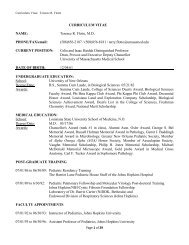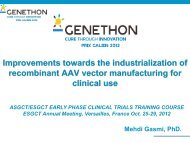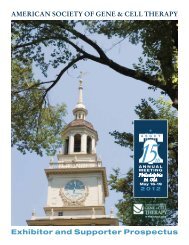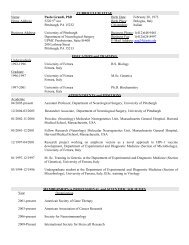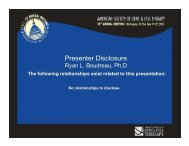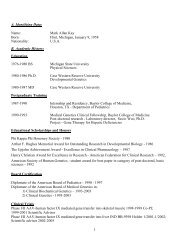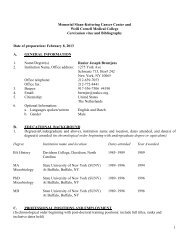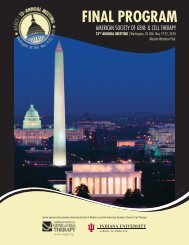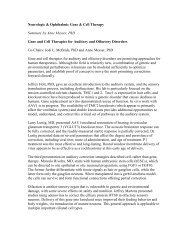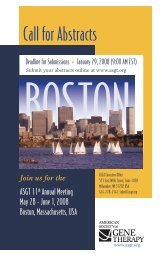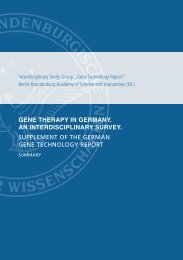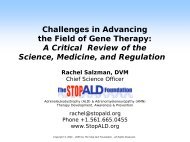FINAL PROGR AM - American Society of Gene & Cell Therapy
FINAL PROGR AM - American Society of Gene & Cell Therapy
FINAL PROGR AM - American Society of Gene & Cell Therapy
You also want an ePaper? Increase the reach of your titles
YUMPU automatically turns print PDFs into web optimized ePapers that Google loves.
26<br />
8th Annual Meeting • June 1 - 5, 2005 • St. Louis<br />
SCIENTIFIC <strong>PROGR</strong><strong>AM</strong><br />
WEDNESDAY, JUNE 1, 2005<br />
Education Session 104<br />
Expression Cassette Design<br />
<strong>Gene</strong> <strong>Therapy</strong> projects require expression <strong>of</strong> an exogenously<br />
introduced therapeutic gene. In The 1995 Orkin and Motulsky<br />
report identified inadequate knowledge <strong>of</strong> vector components<br />
necessary to maintain adequate expression <strong>of</strong> the therapeutic gene<br />
as a major fault in the field. Over the last 10 years, a significant<br />
amount <strong>of</strong> effort has been invested toward the development <strong>of</strong><br />
optimized expression cassettes that provide sustained, high – level<br />
expression <strong>of</strong> therapeutic proteins in relevant disease models with<br />
viral and non – viral vectors. This session will provide guidance<br />
for the development <strong>of</strong> expression cassettes yielding high level,<br />
sustained expression <strong>of</strong> a desired therapeutic protein. The three<br />
presentations will provide (1) an overview to expression cassette<br />
design for viral and non – viral vectors, with a focus on using<br />
viral and house – keeping promoters for highest level <strong>of</strong> gene<br />
expression initially following gene transfer, (2) strategies that have<br />
been successfully used to provide sustained, high level tissue –<br />
specific expression, and (3) vector strategies that optimize protein<br />
expression through the use <strong>of</strong> optimal intron configuration and<br />
mRNA splicing, mRNA stability elements and translation<br />
initiation site configuration. A question and answer session will<br />
follow.<br />
Room: 123/127<br />
Chair: Mitchell Finer, PhD<br />
Speakers: Mitchell Finer, PhD - Expression Cassette<br />
Design - 20 Years in 20 Minutes<br />
Carol H. Miao, PhD - Establishment <strong>of</strong><br />
High-Level and Tissue-Specific <strong>Gene</strong> Expression<br />
Cassettes<br />
Thomas J. Hope, PhD - Post Transcriptional<br />
Regulation in <strong>Gene</strong> Expression Vectors<br />
Education Session 105<br />
Cancer <strong>Gene</strong> <strong>Therapy</strong><br />
Cancer has been a target application for numerous gene therapy<br />
trials. Recent advances in the use <strong>of</strong> oncolytic viruses, the type <strong>of</strong><br />
anticancer transgenes employed for biologic effects and the effects <strong>of</strong><br />
the immune system will be discussed. The understanding <strong>of</strong> these<br />
topics will facilitate improved applications in human trials.<br />
Room: 240 Complex<br />
Chair: E. Antonio Chiocca, MD, PhD<br />
Speakers: E. Antonio Chiocca, MD, PhD - HSV<br />
Oncolytic Viruses<br />
Glen Barber, PhD - VSV as an Oncolytic Vector:<br />
Mechanisms <strong>of</strong> Action<br />
Noriyuki Kasahara, MD, PhD - Retrovirus<br />
Vectors for Cancer <strong>Gene</strong> <strong>Therapy</strong>: Oncolytic,<br />
Anti-angiogenic, and Immunotherapeutic Strategies<br />
BREAK – 5:00 PM - 5:15 PM<br />
EDUCATION SESSION II – 5:15 PM - 6:45 PM<br />
Education Session 110<br />
Adenovirus Vectors<br />
The goal <strong>of</strong> the Adenovirus Education Session is to survey the<br />
current state-<strong>of</strong>-the-art in our development and use <strong>of</strong> adenovirus<br />
gene transfer vectors. The session will begin with a discussion <strong>of</strong><br />
the molecular biology <strong>of</strong> adenovirus including the production <strong>of</strong><br />
replication –deficient vectors and packaging cell lines, the benefits<br />
and deficits <strong>of</strong> deletions <strong>of</strong> subsets or all the viral genes in the<br />
vector, the logic behind conditionally replicating adenoviruses, and<br />
variations relating to the Transgene expression cassette. The second<br />
topic <strong>of</strong> discussion will address the efficiency with which<br />
adenovirus interacts with target cells to deliver its genome to the<br />
nucleus. This discussion will include the basic infection pathway,<br />
altered vector tropism, variables relating to target cell type and<br />
physiology, and in vivo vector trafficking. The final topic <strong>of</strong> the<br />
session will be the interaction between adenovirus and the<br />
immune system including innate immunity, acquired immunity,<br />
and strategies for circumventing immune system barriers.<br />
Room: 263/267<br />
Chair: Philip L. Leopold, PhD<br />
Speakers: Neil R. Hackett, PhD - Molecular Biology <strong>of</strong><br />
Adenovirus Vectors<br />
Philip L. Leopold, PhD - <strong>Cell</strong> Biology <strong>of</strong><br />
Adenovirus Infection: Subcellular Mimicry<br />
James M. Wilson, MD PhD - Immunology <strong>of</strong><br />
Adenoviral Vectors<br />
Education Session 111<br />
HSV Vectors<br />
This session will describe design features and production features,<br />
plus experimental and therapeutic uses <strong>of</strong> recombinant oncolytic,<br />
replication defective and amplicon vectors derived from herpes<br />
simplex virus type 1. Oncolytic vectors are designed for treatment<br />
<strong>of</strong> cancer based on targeted delivery and selective virus replication<br />
in tumor cells. Clinical trials using these vectors for brain tumors<br />
will be described. Replication defective viruses deleted for essential<br />
viral functions have been engineered for peripheral nervous system<br />
applications since they naturally persist in sensory nerves following<br />
local delivery to the skin. Amplicon vectors incorporate no viral<br />
genes and can include up to 150 kb <strong>of</strong> genetic information,<br />
including complete genes, self-contained regulatory elements and<br />
AAV genome integrating components. These vectors provide<br />
versatile tools for systematic genetics and therapeutics.<br />
Room: 260/264<br />
Chair: Xandra Breakefield, PhD<br />
Speakers: Xandra Breakefield, PhD - Mega-multi<br />
Capacity HSV Amplicon Vectors<br />
Joseph C. Glorioso, PhD - HSV <strong>Gene</strong> Vectors<br />
for Treatment <strong>of</strong> Pain and Neuropathy<br />
E. Antonio Chiocca, MD, PhD - HSV Vectors<br />
for Chemotherapy Delivery



